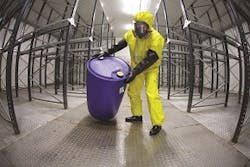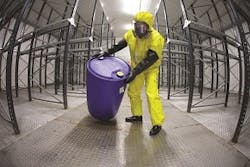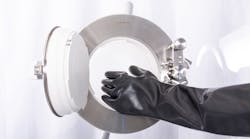These challenges include:
• Can personnel and the environment involved in the manufacture of high potency products be protected;
• Can adequacy of controls preventing contamination of other products by highly potent materials be demonstrated; and
• Can the expectations of clients and/or regulators regarding separation or segregation of manufacturing activities be satisfied?
CLASSIFIED AS HIGHLY POTENT
Many companies are choosing to outsource the manufacture of their highly potent compounds for strategic and/or economic reasons. Approximately 25 percent of drugs currently in development worldwide are classified as highly potent, with forecasts suggesting that their increasing therapeutic use is expected to drive the global market for HP Active Pharmaceutical Ingredients (HPAPIs) by an estimated compound annual growth rate of 9.9 percent from 2012 to 20181. While the majority of HP drugs are anti-cancer compounds (the oncology sector alone is expected to increase in value from $64 billion in 2011 to $104 billion in 20182), other HP products include therapeutics such as hormones, narcotics and retinoids.
HPAPIs DEFINED
The definition3 of a HPAPI varies depending on the literature, but generally is defined as:
• A pharmacologically active ingredient or intermediate with biological activity at approximately 150 μg/kg of body weight or below in humans (therapeutic daily dose at or below 10 mg).
• An API or intermediate with an occupational exposure limit (OEL) at or below 10 μg/m3 of air as an 8-hour time-weighted average.
• A pharmacologically active ingredient or intermediate with high selectivity (i.e., ability to bind to specific receptors or inhibit specific enzymes) and/or with the potential to cause cancer, mutations, developmental defects or reproductive toxicity at low doses.
• A novel compound of unknown potency and toxicity.
Before progressing to define required levels of separation or segregation, anyone involved in the manufacture of HP materials must first address the issue of API
classification since regulatory guidelines and regulations throughout the world can be inconsistent and often vague.
The International Society of Pharmaceutical Engineering (ISPE) sought in RiskMaPP4 to engage with regulators and build an approach that would address the impreciseness of the classification approach and replace it with a clearly defined characteristic of active pharmaceutical materials, with the concept being that all manufacturers would demonstrate the adequacy of their controls (used to prevent cross-contamination) referencing the chosen characteristic. Risk-MaPP is defined as providing a scientific risk-based approach, based on ICH Q9 Quality Risk Management, to manage the risk of cross contamination in order to achieve and maintain an appropriate balance between product quality and operator safety.
USE ADE SAYS ISPE
Specifically, the ISPE guideline proposes the use of health-based Acceptable Daily Exposure (ADE) values rather than a tag such as “hormone,” “steroid” or “cytotoxic” (with the exception of cephalosporins, which were specifically omitted from the guide). These values would then be used to assess the risk of cross-contamination and ultimately determine the level of controls to be applied along with any facility design and building requirements. Many of what are described as “tagged products” will have very low ADEs and, as a result, any true assessment of their potential risk will place a significant burden on the manufacturer to demonstrate containment and separation.
As a company, Alkermes incorporated RiskMaPP into how it manages and assesses the risk of cross-contamination across all the products it manufactures, including those with very low ADEs (μg/day).
However, while the U.S. Food and Drug Administration (FDA), the European Medicines Agency (EMA) and others have endorsed risk-based assessments in this area, not all regulators or indeed inspectors share the same view at this point.
To better understand and mitigate the overall risks, a detailed investigation of a company’s approach to handling and processing HP compounds should be performed. This analysis should challenge capability and knowledge in potent compound safety (both occupational and environmental), assessing the organization’s understanding of cross-contamination risk, of how the product might be affected by other compounds produced at the prospective site, and how current products might be affected by possible introduction of the new product. Key elements to be considered include:
• Compound evaluation and OELs
• Equipment and process containment
• Environmental management
• Procedures and training
• Global compliance
• HPAPI handling experience and expertise
EVALUATING OELS AT ALKERMES
A first step when considering the introduction of any new API is to assess the toxicity and potency of the compound and to categorize it (“control banding”). Alkermes, for example, developed a categorization scheme with input from SafeBridge Consultants. Alkermes considers this an important first step in facilitating the assessment of likely product demands relative to the capability of existing manufacturing equipment technology and/or the ability to enhance its processing approach. Control banding provides a means to group materials by their hazards and risk of exposure so that suitable consistent controls can be defined and applied to ensure safe handling.
There are several limitations associated with banding approaches, so as soon as is practicable Alkermes moves to generate both ADE and OEL values. If Alkermes has a history of dealing with either the sponsor or the organization that’s generated the report on their behalf, they will use the data provided by the potential partner, assuming it to be correct, until they can generate their own.
Alkermes typically seeks, as a best practice, to generate combined OEL and ADE reports because similar toxicological data underpins both. Alkermes has established a cross-site review forum for OEL/ADE reports, bringing in-house Environmental Health and Safety (EHS), toxicology and validation experts together to drive consistency and thoroughness in evaluation. Alkermes developed a format for report generation that includes supporting evidence from the toxicologists the company employs. For ADE identification in particular, they demand that formulae and factors applied are consistent with their template, and that any variation from default values used in calculations is explained. Alkermes’ template is based on the process described in the RiskMaPP guidance, and many of the default values the company employs are also based directly on that guidance or on references provided by the ISPE. ADE is a very important element in how Alkermes justifies its assessment of contamination controls — something both U.S. and European regulators that have visited Alkermes’ sites or attended presentations have supported with positive feedback.
Developing an OEL and subsequent testing for the presence of that specific material allows us to empirically demonstrate that the working environment is safe. Concurrent with the development of an OEL, Alkermes commissioned Bureau Veritas (American Industrial Hygiene Association (AIHA) accredited) to develop the industrial hygiene sampling and analytical method to allow monitoring of the workplace to occur.
EQUIPMENT AND PROCESS CONTAINMENT
“If an overall manufacturing facility consists of three components — pharmaceutical material, personnel and the environment surrounding them — containment is the isolation of the first of these components from the other two” (ISPE). Containment, how it is achieved, how it is measured, and how it is maintained are key considerations for any provider handling potent or HP materials. The complexity of solutions relating to the contained material (OEL, material form, how much it is diluted by other components, etc.) and the process being employed (material energy, scale, level of operator intervention required, etc.) are key considerations. Where practicable it is best to manage containment at the source.
There is no one solution suitable to all situations. All challenges must be assessed within the context in which they occur and the constraints that apply. Some of these constraints will be of time and cost. Some assessments will reach a conclusion that projects should not be undertaken.
In assessing the containment challenge, Alkermes considers the three levels of protection:
1. Primary containment — equipment targets isolation of the product from the operators and the environment. Equipment is normally equipped with Clean in Place (CIP)/Wash in Place (WIP) and may be supplemented by a flexible single-use element for interventions
2. Secondary containment — includes use of separate processing rooms
3. Tertiary containment — refers to facility design such as dedicated, segregated suite(s), security access controlled, HVAC single pass air (safe change in room), double HEPA exhaust, pressure cascade and fogging shower.
Providers should establish containment performance criteria during commissioning and show that performance is maintained during commercial manufacture. Alkermes bases its approach on the ISPE Good Practice Guide: “Assessing the Particulate Containment Performance of Pharmaceutical Equipment”5. As part of commissioning, Alkermes uses a suitable surrogate (less potent) material with very low limits of detection to challenge installations. Alkermes also uses routine Industrial Hygiene monitoring to develop a sufficient level of confidence that we are achieving the OELs and verify ongoing containment performance.
When Alkermes considers cross-contamination potential it does so from two perspectives. First, the company considers the source and the risk (Product Risk) that the product presents, and second, it considers the potential risk of the product contaminating others (Product Vulnerability). Where a product of high “vulnerability” is manufactured on the same equipment or adjacent to a source of high-potential, “product risk” is where adequacy of controls needs to be most thoroughly assessed.
ENVIRONMENTAL MANAGEMENT
HPAPIs typically present greater challenges in environmental management including waste disposal, effluent containment and abatement of air emissions compared to less potent pharmaceuticals.
Best practice suggests all liquid and solid wastes, including wash water from equipment and area cleaning, should be contained until its potential for environmental impact is understood. When it comes to third-party manufacturing relationships, initial project assessment can be greatly helped by a thorough donor/sponsor data package. In this context, the information of interest might include any available eco-toxicity data, respirometry and/or biodegradation data, as well as previous waste-handling methods used, abatement systems utilized, etc.
Clearly, the decision to hold all potentially environmentally damaging materials (in particular wash waters, which would typically be of large volume) has cost implications, so drug owners will need to be confident in their own ability or their CMO partner’s ability to reduce wash-water volumes, and by extension, long-term costs.
Certification of a company’s systems relating to handling and disposal of liquid/solid waste products and their environmental management system, along with ready availability of associated written procedures, should give anyone whose job is to promote operational excellence, a good initial feel for his or his partner’s capability and focus. Additionally, regulatory history and/or licensing of facilities will provide the donor with further assurance of the company’s environmental management capabilities. Alkermes’ environmental management system, for instance, is certified against international standard ISO14001 and is assessed against an Integrated Pollution Prevention Control License which is regulated by the Environmental Protection Agency (EPA) in Ireland.
Training and expertise of people involved in the design of facilities, equipment and manufacturing processes as well as those who will handle and manage products in commercial manufacture will be critical to success. Alkermes itself invests significantly in the training of its scientists and engineers to ensure implementation of the best operable design to meet the specified containment performance target. In addition, operators and support staff are trained so they can maintain and operate equipment effectively and understand why containment and controls are in place. It’s axiomatic that the discipline and care required from personnel operating and maintaining a facility handling HP compounds, their understanding of how their actions may influence exposure levels, and their understanding of risk are fundamental for the safe and successful operation of the plant.
Any organization seeking a third party to process HPAPIs should pay close attention to the training and expertise of all those who might be involved in process design, transfer, qualification (GMP & safety aspects) and eventual operation.
REFERENCES
1 High Potency Active Pharmaceutical Ingredients (HPAPIs) Market - Global Industry Analysis, Size, Growth, Share And Forecast 2012 – 2018, Transparency Market Research, Nov 2012
2 High Potency API Roundtable, Pharmaceutical Outsourcing, July 23, 2012
http://www.pharmoutsourcing.com/Featured-Articles/117704-High-Potency-API-Roundtable/
3 ISPE Baseline® Guide: Risk-Based Manufacture of Pharmaceutical Products (Risk-MaPP)
http://www.ispe.org/baseline-guides/risk-mapp
4 RiskMaPP definition and resources https://www.ispe.org/risk-mapp-resources
5 ISPE Good Practice Guide: Assessing the Particulate Containment Performance of Pharmaceutical Equipment (Second Edition)






